Introduction
A bit about genes
DNA is the instruction manual for life. In our DNA is all the information needed to build our bodies and make them work. That whole set of instructions is found in most of our cells. Humans have nearly 20,000 genes in our DNA. Often, many different genes are involved in controlling a trait, like the color of our eyes. But sometimes, it comes down to just one gene. In this game, we will be looking at traits controlled by a single gene.
Each gene has a specific location (called its locus) on a strand of DNA. Most of our cells have two copies of DNA, one from each of our parents. This means a cell has two copies of the same gene for each trait. Sometimes, both copies of the genes are the same. But other times, the DNA has two different versions of the same gene. Alternate versions of the same gene are called alleles. An allele is represented as a single letter.
The two alleles as a pair make up the genotype of an individual. Think of the gen-otype as the gen-etics that an organism has. So, the genotype is the two alleles they carry for the gene. The way those alleles show up as a trait is the phenotype. Think of the ph-enotype as the ph-ysical way the alleles show up.
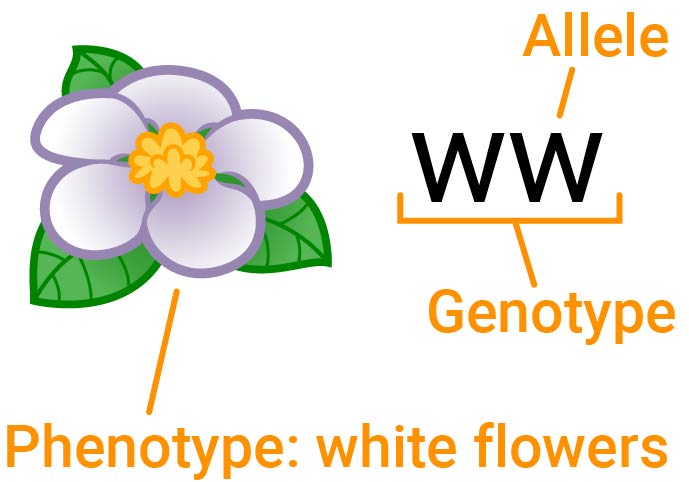
Describing pairs of alleles
To know how these alleles relate to each other, we need to know if the two copies are the same or different. If the two alleles are the same, the pair is called homozygous. If the two alleles differ, the pair is called heterozygous.
When the two alleles are homozygous (the same), the effect of that allele will show up. When they are heterozygous (different), then we have to think a bit more about what trait will show up.
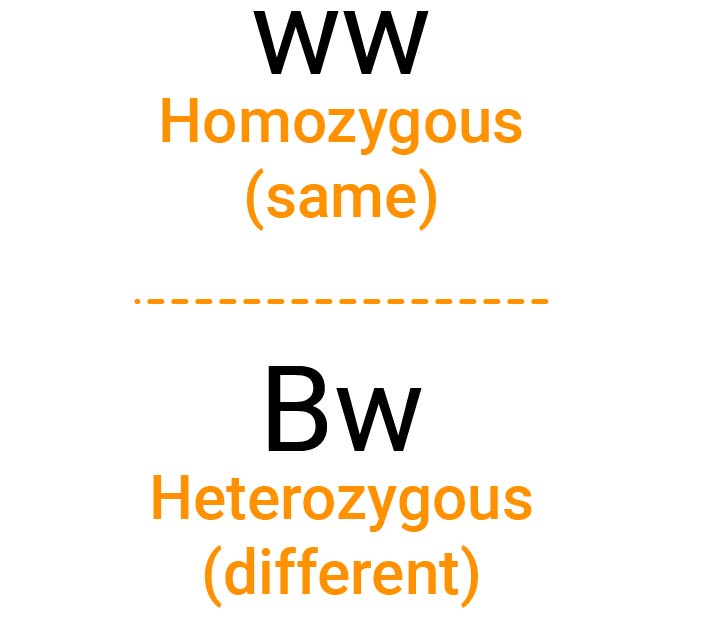
Types of dominance
Alleles can relate to each other in different ways, depending on the type of dominance. We can have complete dominance, when the effects of only one allele shows up. We can have incomplete dominance, when the effects of both are blended. Or we can have codominance, when the trait of each allele shows up at the same time.
Let's think about this in terms of paint.
With complete dominance, we have dominant alleles, which will always show up if they are present. Let's say the dominant allele color here is blue. We also have recessive alleles, and these are like having a nearly clear paint. When the clear (recessive) is present with the blue (dominant), you can only see the blue color. Blue must be absent for the clear to be noticeable. In the same way, with complete dominance, you only see the recessive trait if a dominant allele is not there. That means you must have two recessive alleles for the recessive trait to show. Dominant alleles are often shown as uppercase letters. Recessive alleles are usually shown as lowercase letters.

In incomplete dominance, neither of the traits will show up fully. Instead, you end up with a mix of the two. Let's look at alleles for a blue and a yellow color. Under the rules of incomplete dominance, when the two are paired, you would get green. The “incomplete” can help you remember that you don't end up seeing either of the colors in full here, but instead you see a mix of the two.

With codominance, both colors will show up. This means you might get stripes, or polka dots, or some other coloring where some blue is visible and some yellow is visible. The co- at the beginning of the word can be thought of as the two colors co-operating. They share the space. One shows up in some areas and in other areas, the other shows up.
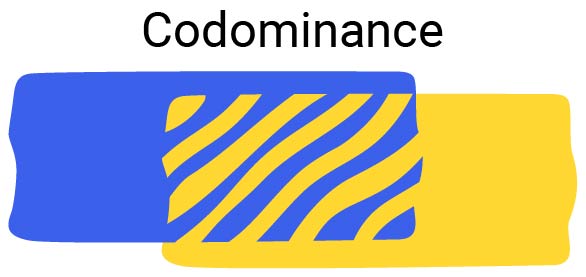
Chances of allele combinations
Now let's imagine that these alleles are for flower color. And let's imagine that you want to grow a garden of flowers, but you want to know what types of flowers will show up. This is where Punnett squares come in. A Punnett square is a tool that helps you see which alleles and traits you can get when you breed (or cross) certain parents.

Using Punnett squares
In a Punnett square, the alleles of two breeding parents go on the outside of the square. The two alleles from the first parent are often written at the top of the square. The two alleles from the second parent are often written on the left side. The alleles get split up so each has their own column (for the top parent) or their own row (for the side parent). The chances of them passing on one allele over another are equal, so each allele has the same odds of being passed on to a child.
The square is completed by drawing each parent allele in the two children's boxes that it aligns with. For parents on top, one letter is put in each of the boxes in the column below them. For parents on the side, one letter is put in each of the boxes in the row to the right of them. The result will be two letters in each of the four children boxes, one from each parent.
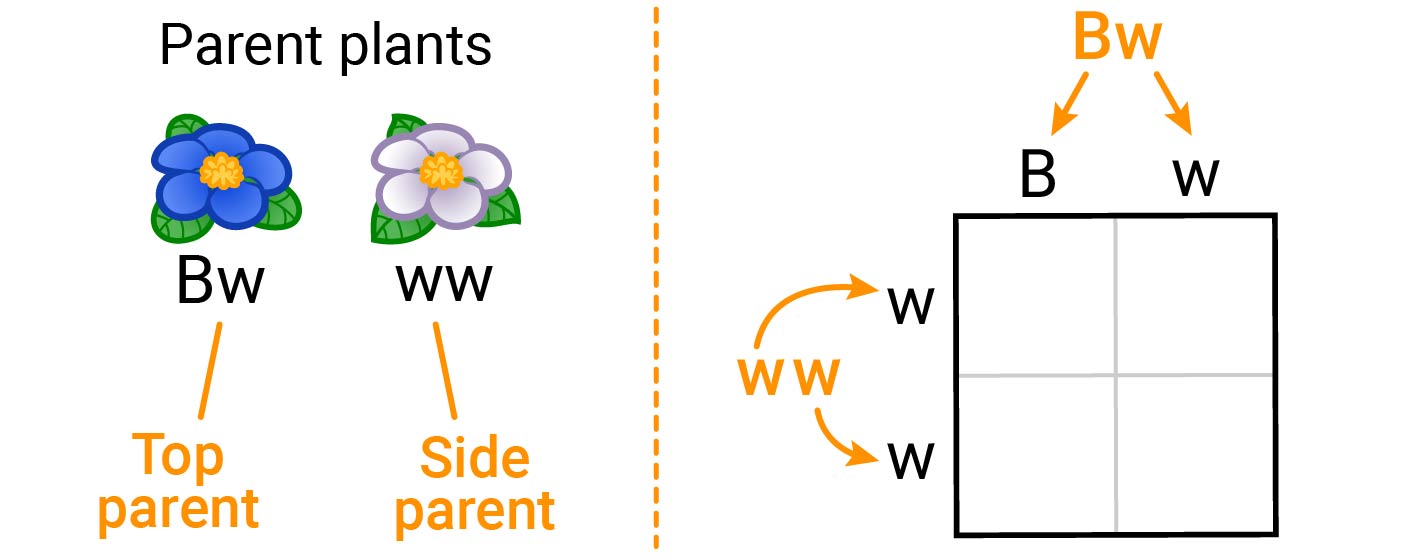
In each box, those two letters show what the genotype of the children could be. For every child made from this cross, there's a ¼ chance (1 box out of the 4 boxes) that it will have that specific genotype.

Once you've found the genotype for all four of the boxes, you can also see what their phenotypes will be. For this, first you'll need to think about what type of dominance the trait has. Then, you'll need to figure out how the two alleles relate, and what offspring traits the two parents might make. Remember, the phenotype is based on the genotype, but it's the actual trait that shows up. Again, for every child made from this cross, there's a ¼ chance (1 box out of the 4 boxes) that it will show that specific trait.
Genotype and phenotype ratios
It can also be important to know the genotype and phenotype ratios. The ratios include all the children in the Punnett square. These ratios show how likely offspring are to get a specific set of alleles or traits. For genotype ratios, you look at the actual alleles present in the four boxes. For phenotype ratios, you look at the traits (like color) that will show from the given genotypes.
In some cases, breeding two parents will only be able to make one type of offspring. Here, because all the offspring would have the same genotype (and so, phenotype), the ratio is 1. If both parents are homozygous for the same alleles, this is called a true breeding cross. A true breeding cross is when parents and their offspring will only produce the one phenotype for many generations.
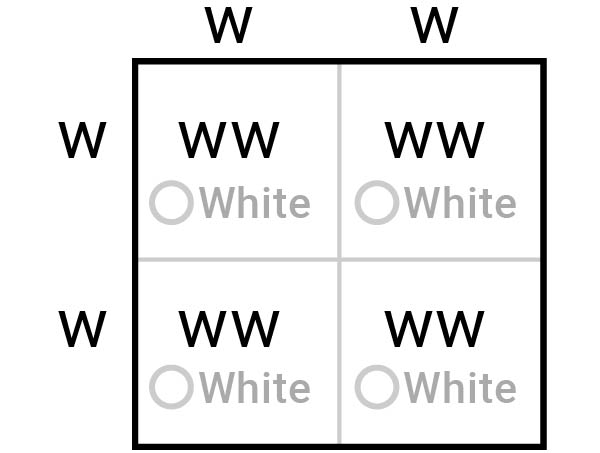
If one of the parents is heterozygous and the other is homozygous, that will create a genotype ratio of 1 : 1. In this case, with complete dominance, the phenotype ratio would be 1. When the recessive allele is present, it is paired with a dominant allele, so the recessive trait won't show up.
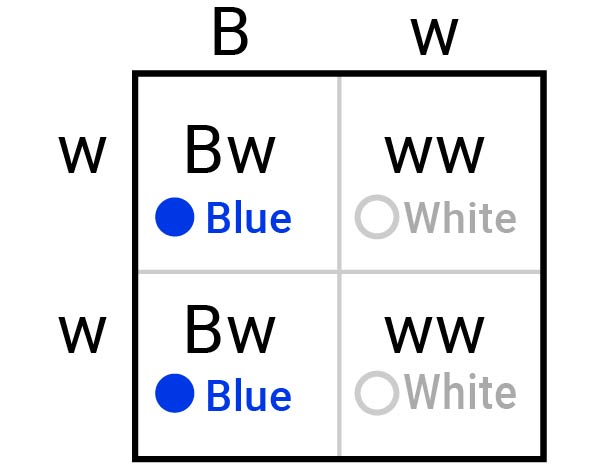
One of the most diverse crosses you can get is from two parents that are both heterozygous for the same trait. This will create a genotype ratio of 1 : 2 : 1. If this is under the rules of complete dominance, that will end up in a phenotype ratio of 3 : 1.

Random chance and unusual outcomes
Once you've done a Punnett square, you can see all the genotypes and phenotypes that can be made from that cross, with one exception. The squares don't account for mutations. However, the number of each genotype or trait you actually get from a cross may differ from what you expected. Which alleles are passed on to every child is left up to chance, so then it just comes down to probability.
If you get flower color percentages in your garden that vary wildly from what you expected, think of that as a special outcome… and one that you aren’t likely to get again!

Summary
- Alleles are alternate versions of the same gene and are represented as a single letter
- Two alleles make up the genotype of the individual, for example, Bw or ww
- The trait that alleles make is the phenotype of the individual, for example, blue or white
- If the two alleles are the same (ww, for example), the pair is homozygous
- If the two alleles are different (Bw, for example), the pair is heterozygous
- In complete dominance, a dominant allele will mask a recessive allele entirely
- In incomplete dominance, traits can mix and neither is dominant
- In codominance, two traits can show up and share the space, neither is dominant
- A Punnett square helps you predict the possible offspring of a set of parents
- Parent alleles go outside the square and are added to corresponding rows or columns
- Children boxes should end up with two alleles each
- The four children boxes can be used together to find genotype and phenotype ratios
- These ratios show you how likely offspring are to get a specific set of alleles or traits
- A true breeding cross is when the parent genotypes both match all the children genotypes